While the main focus of this blog post is on North Dakota’s official state fish and where to catch it, it’s important to provide a brief overview of the state itself. North Dakota is located in the Midwestern region of the United States and borders Canada to its north. It covers an area of over 70,000 square miles and has a population of around 760,000 people. The capital city is Bismarck, and other major cities include Fargo (the largest city), Grand Forks, Minot, and Dickinson.
North Dakota’s economy is largely based on agriculture, with wheat being one of its biggest crops. The state also has significant oil reserves that have been a driving force behind its recent economic growth. In terms of outdoor recreation, there are plenty of opportunities for fishing, hunting, hiking, camping, and more throughout the state.
Overall North Dakota offers visitors a unique blend of natural beauty and modern amenities. Whether you’re interested in exploring national parks or enjoying world-class dining experiences, there truly is something for everyone here!
North Dakota State Fish
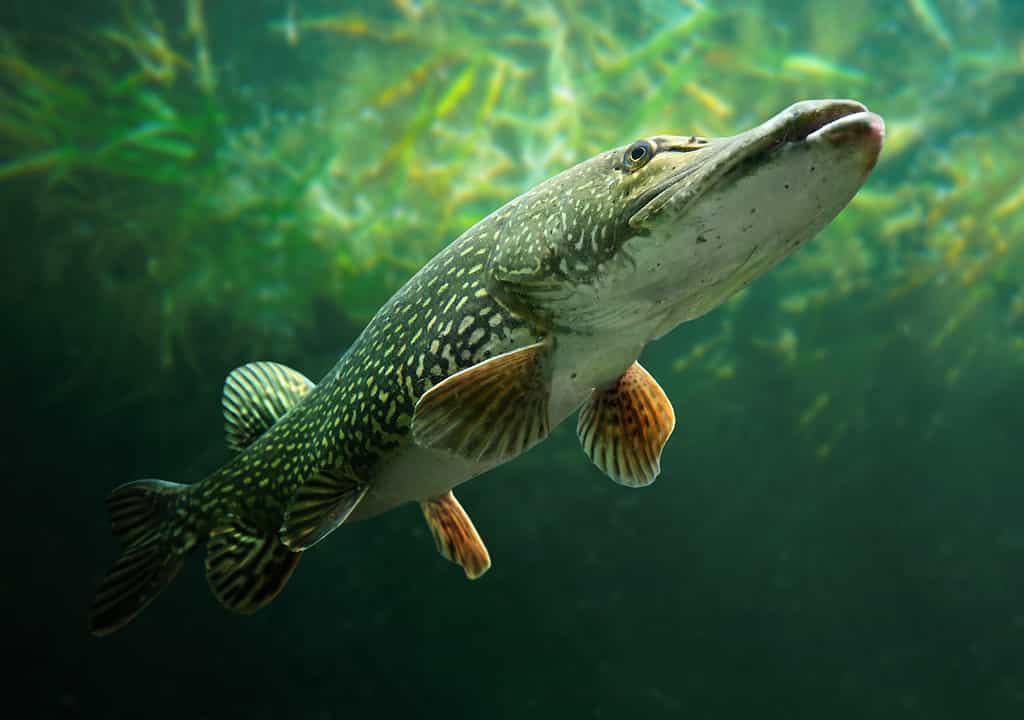
One of the most noticeable physical features of the northern pike is its long snout filled with sharp teeth that jut outwards.
©iStock.com/abadonian
The northern pike (Esox lucius) is the official state fish of North Dakota.
The northern pike (Esox lucius) is a predatory fish species found in North Dakota’s waters, and it is also the official state fish of the region. This elongated freshwater fish can grow up to 4 feet in length and weigh over 20 pounds. It has a distinctive appearance with its olive-green back, yellowish sides, and white belly. Its body is covered with small scales that help protect it from predators.
One of the most noticeable physical features of the northern pike is its long snout filled with sharp teeth that jut outwards. These teeth are perfect for catching prey such as other smaller fishes, frogs, or even small birds that may fall into the water. The dorsal fin of this species runs along almost all of its spine and has five to seven pores on each side.
Northern pikes have an adipose fin located near their tail which helps them balance while swimming or hunting for food. They also have two pelvic fins located just below their gills, used for steering through the water column.
In summary, when you encounter a northern pike in North Dakota’s waters during your summer fishing trip – expect to see an elongated predator sporting distinctive coloration patterns such as olive green upper bodies gradually fading into a lighter shade towards yellowish sides culminating in white bellies complemented by sharp-toothed snouts suited for successful predation techniques without forgetting about dorsal fins running along almost all spines!
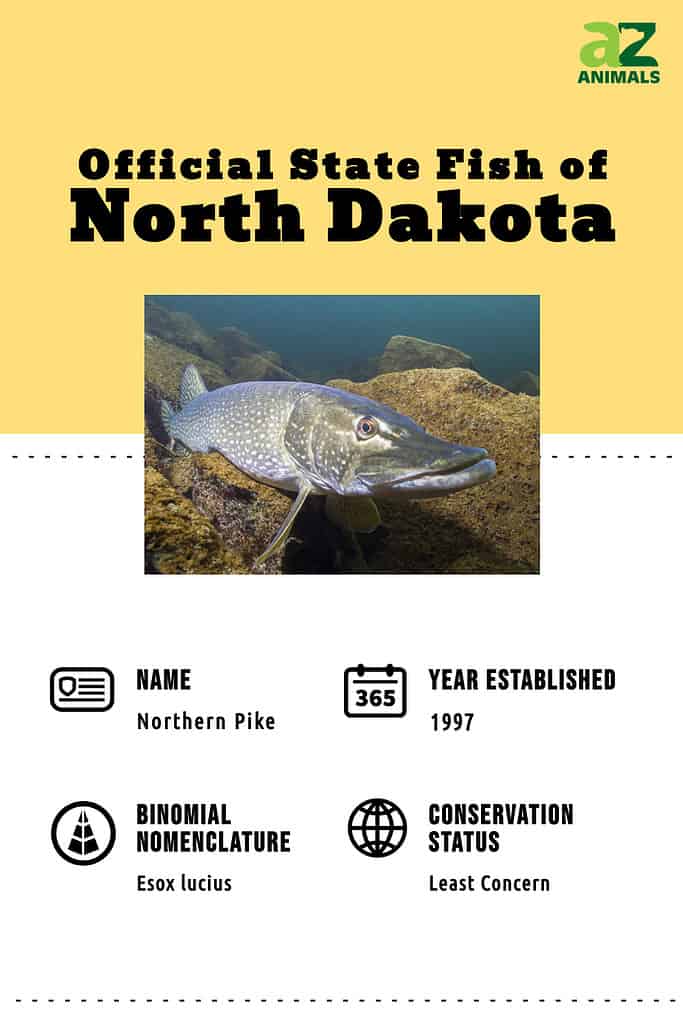
Where to Catch a Northern Pike
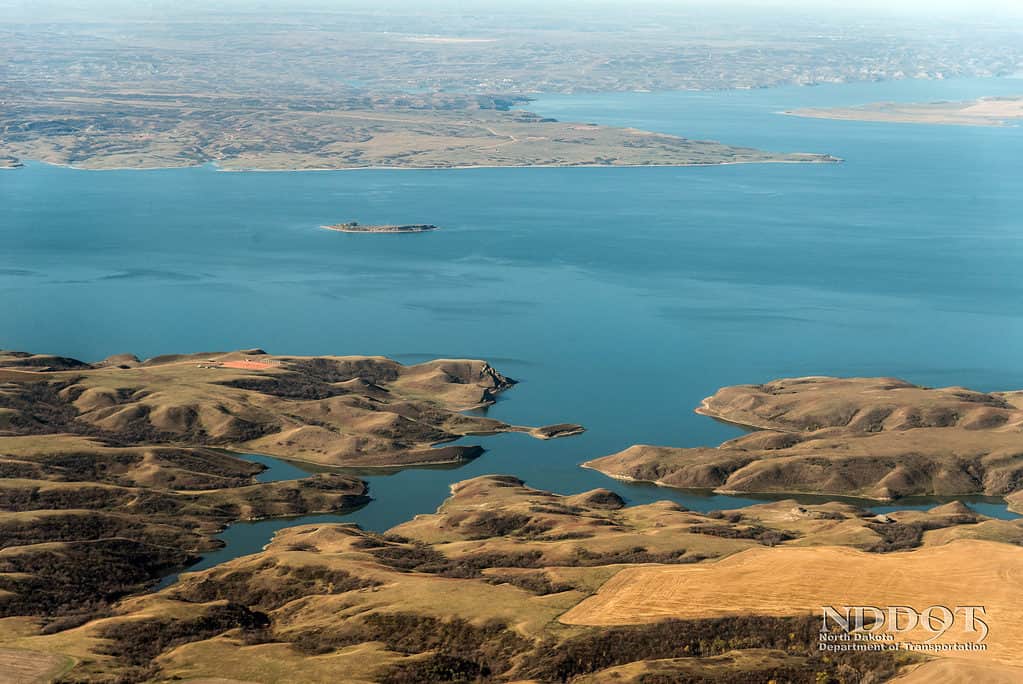
Lake Sakakawea, North Dakota, is a good place to catch the northern pike.
©North Dakota / Flickr – License
Northern pike is a freshwater fish species that can be found in a variety of habitats, including lakes, rivers, and streams. They prefer clear water with plenty of vegetation for cover and ambush points to catch prey. Pike are found in slow-moving, shallow water that has plenty of weeds where they can wait for prey for long periods.
In North Dakota specifically, northern pike is commonly found in the state’s larger lakes, such as Lake Sakakawea, Lake Oahe, Devils Lake, and the Jamestown Reservoir. These lakes have varying depths and structures that provide ideal habitats for northern pike to thrive in.
When fishing for northern pike in these locations, look for areas where there is ample vegetation or submerged structure, such as fallen trees or rocks. northern pike tends to hide out within these structures, waiting for unsuspecting prey to swim by.
Overall, understanding the preferred habitat of northern pike can greatly improve your chances of catching them during your summer fishing trip in North Dakota.
Diet and Bait
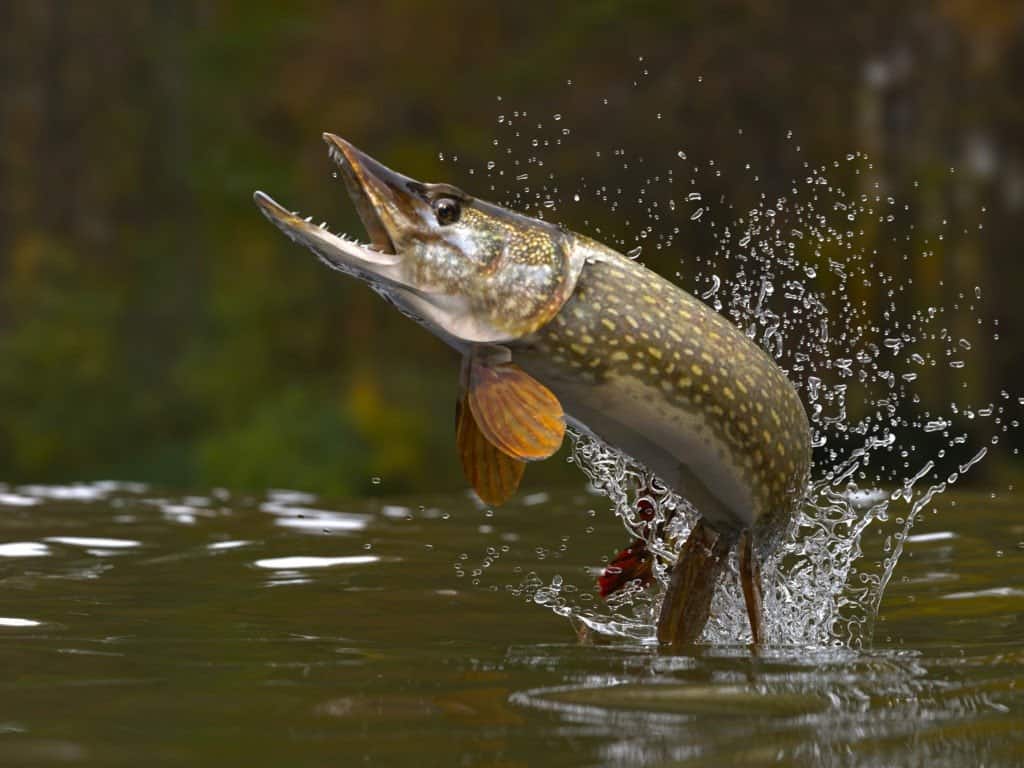
Northern pikes are aggressive fish and fun to catch and release.
©bekirevren/Shutterstock.com
Northern pike is a carnivorous fish that primarily feeds on other smaller fish but will also eat crayfish, frogs, and small mammals, like baby ducks. They are ambush predators that lie in wait for their prey to swim by before striking with lightning-fast speed. When hunting, they rely heavily on their keen sense of sight and lateral line system to detect vibrations in the water.
To catch northern pike, anglers typically use live bait such as minnows or leeches. Artificial lures such as spoons or crankbaits can also be effective if used correctly. It’s important to match the size of the bait or lure to the size of the fish being targeted. Larger bait and lures may attract bigger pike but could scare away smaller ones.
When fishing for northern pike in North Dakota, anglers should check local regulations before heading out on the water to ensure compliance with size limits and bag limits for this species.
Reproduction
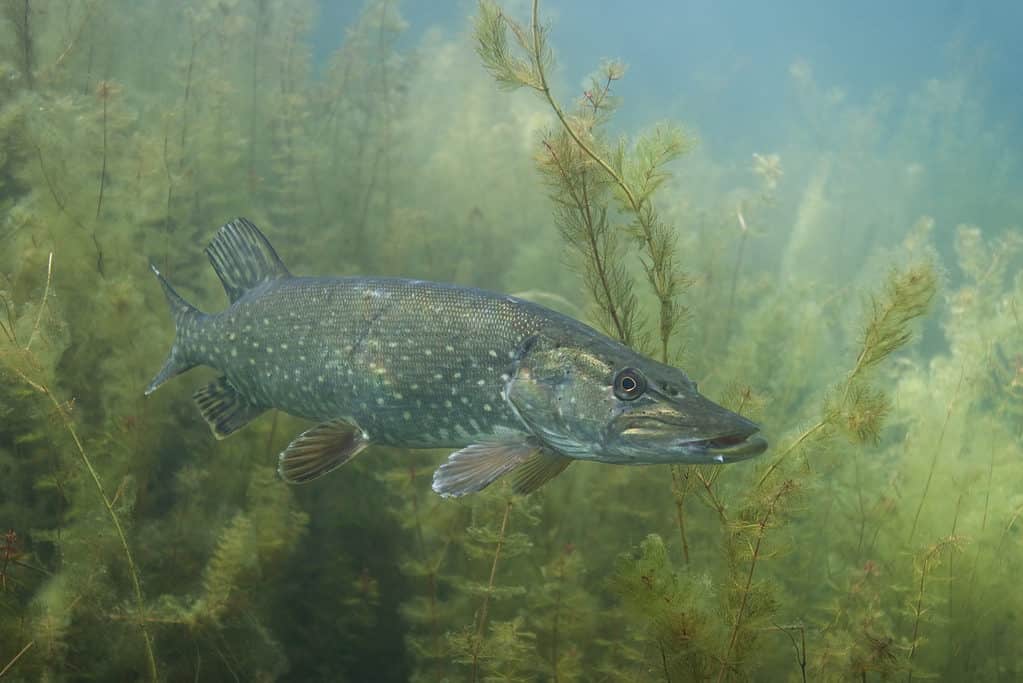
Northern pike breed when they are two years old. They can live to be over 12 years old!
©Martin Prochazkacz/Shutterstock.com
If you’re curious about the reproduction habits of northern pike, we have some fascinating information for you. These fish are physically capable of breeding at just two years old, and they typically spawn in the spring after water temperatures reach 48°F. To ensure a high success rate, female pike lay a large number of eggs during this time.
However, it’s worth noting that these eggs will not hatch if the water temperature drops below 43°F. This means that timing is crucial when it comes to northern pike reproduction.
Interestingly, male pike tend to arrive at their breeding grounds a few weeks before females do. This gives them time to establish territories and prepare for mating season.
Unfortunately, mortality rates among young fry can be quite high due to environmental factors such as toxicity or pollution in the water or rapid changes in temperature. Environmental pollution can greatly impact northern pike populations’ overall health and survival.
Finally, if you ever come across northern pike eggs during your fishing adventures (they’re sticky and yellow-orange), take a moment to appreciate this amazing example of nature in action!
Cooking
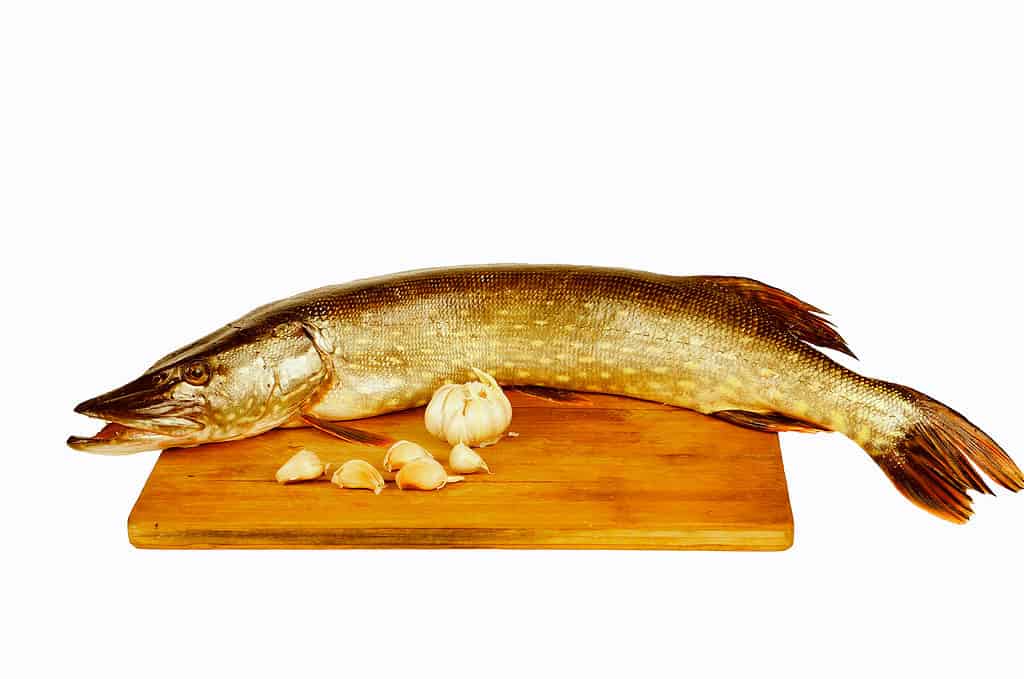
Another name for northern pike is chain pickerel.
©banosan/Shutterstock.com
Northern pike is a popular fish in North Dakota, and many people enjoy eating it. The key to preparing northern pike is to remove the Y-bones, which can be challenging for some but with practice, it becomes easier. One way to do this is by filleting the fish into two sides, then making a cut along the top of each side and pulling out the bones from there.
In terms of taste, northern pike has a mild flavor that some compare to walleye or bass. It’s not overly fishy or strong, which makes it appealing to those who may not typically enjoy seafood. Additionally, Northern Pike can be prepared in many different ways, including grilling, frying, or baking.
While northern pike does have bones, they are generally easy enough to remove once you know how. This means that even novice cooks shouldn’t shy away from trying their hand at cooking this delicious freshwater fish. So if you’re looking for something new and exciting to try on your next fishing trip in North Dakota, consider catching some northern pike!
Conservation and Threats
As with any species, the conservation status of the northern pike is an important consideration. While they are not currently listed as endangered or threatened, their populations can be impacted by a number of factors. Overfishing and habitat loss due to development are two significant threats to the species.
In addition to these direct impacts, climate change may also pose a threat to northern pike populations in North Dakota and beyond. As temperatures warm, aquatic habitats may become less hospitable for cold-water fish like pike. Changes in water chemistry and other environmental factors could also impact their survival.
To help protect northern pike populations, conservation efforts often focus on maintaining healthy habitats where the fish can thrive. This might include measures such as restoring wetlands or implementing regulations around fishing practices. Due to these concerns, many anglers use catch-and-release techniques to keep the spawning populations high.
The photo featured at the top of this post is © iStock.com/abadonian
Thank you for reading! Have some feedback for us? Contact the AZ Animals editorial team.







